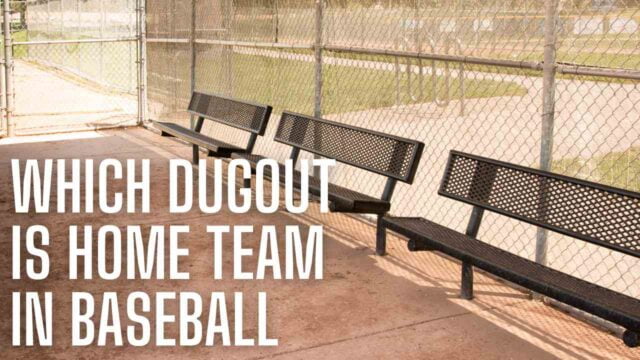The debate around whether Pitching From the Stretch vs Windup has been going on for decades in the baseball world. Both pitching From the Stretch vs Windup techniques have their own unique advantages and disadvantages. In this in-depth blog post, we’ll analyze the key differences between these two delivery methods to help players and coaches determine which one is the better option.
What is the Windup Pitching Motion in Baseball?
Pitching From the Stretch vs Windup
The windup is the classic way of pitching that begins with the pitcher standing tall on the rubber, facing straight towards home plate. They start by lifting their lead leg up into a “high leg kick” before striding forward and releasing the ball toward the catcher’s mitt.
This full circular motion allows pitchers to utilize the strength in their entire body, building momentum through the hips and core that generates more power and speed on their pitches. The windup gives hurlers time to get comfortable, relax, and focus on their pitching mechanics before delivering each pitch. To further understand pitching mechanics, explore these detailed pitching insights.
The origins of the windup stretch all the way back to the earliest days of baseball in the 1800s. Pitchers would simply rear back and throw the ball with an underhand motion. As the game evolved, sidearm and overhand throwing motions were introduced in the 1870s which led to different variations of pitching styles.
The classic windup technique became the predominant way to pitch by the early 1900s. One of the biggest advantages it offered pitchers was the ability to use different arm angles and alter pitch speeds. This made it very difficult for batters to adjust to a pitcher’s delivery. A better understanding of the pitcher’s role can be gained by learning about how many players are on a baseball team

Pros of Using the Windup Pitching Motion
There are several advantages that the windup pitching technique provides:
- Generate more power and speed by building momentum from the legs and core
- Allows pitchers time to settle in, get comfortable, and focus before each pitch
- Opportunity for a high leg kick which engages the lower body
- Deceives hitters with a consistent smooth rhythm and timing
- Puts less strain on the arm compared to pitching from a stretch
- Keeps batters off balance with a good mix of pitch locations and speeds
- Opportunity to use the whole body, not just the arm, to build velocity
- Provides good balance point before striding towards home plate
- Intimidating to batters when they see the pitcher rear back for delivery
- Gives the pitcher a chance to shake off the previous pitch and reset
Cons of the Windup Pitching Delivery
However, there are also some disadvantages or challenges when pitching from the windup:
- Slower delivery gives baserunners more time to take leads and steal
- Increased motion can be more tiring on the arm and body
- Not as deceptive as the stretch delivery
- Requires good coordination to execute proper timing
- More complicated mechanics can be difficult to master
- Multiple moving parts makes consistent release point tough
- Leaving the set position too early could result in a balk

What is Pitching from the Stretch in Baseball?
When pitching from the stretch vs windup, the hurler stands tall on the rubber with their pivot foot touching the pitching plate. Their other foot is positioned sideways, facing either first or third base depending on if they are right or left-handed.
There is no windup used from this set position. Pitchers simply lift their legs, rotate their hips, stride forward, and deliver the pitch toward home plate. This pause allows them to gain proper balance before firing towards the target. For younger players, understanding the differences in pitching techniques is crucial, as outlined in this guide on 10u baseball pitching distance.
The pitching delivery from the stretch is much more compact and controlled. Pitchers are able to vary the look by altering their leg kick, doing a slide step, or even using somewhat of a hybrid technique. This provides more opportunities to disrupt the timing of batters.
The stretch is primarily used when there are runners on base as it allows pitchers to better control the running game. By eliminating the big windup, they can deliver the ball home much quicker to give the catcher a better chance to throw out stealing baserunners.
Pros of Using the Stretch Pitching Technique
Here are some of the main benefits of using the stretch pitching delivery:
- Much faster delivery home which controls opponent’s running game
- Simplistic and repeatable mechanics are less taxing on the arm
- Easier to hold baserunners close to their bases
- Variety of moves can disrupt batter’s timing and comfort zone
- Changes hitter’s eye level and glance with different leg kick
- Allows pitchers to pitch exclusively from the set regardless of situation
- Deceptive slides step catches runners off guard
- Greater ability to pick off or throw out stealing baserunners
- Forces batters to make quicker reactions and decisions
- Varying looks keep hitters off balance and uncomfortable
- Focuses power from legs and core instead of just the arm

Cons of Pitching from the Stretch
Pitching exclusively from the stretch also has its challenges:
- Reduced time to settle in and focus before each pitch
- Lack of windup may decrease velocity and power generation
- Difficult to get comfortable release point without windup
- May require more pitches to find command of the strike zone
- Doesn’t allow high leg kick so pitchers can’t use lower body as much
- Changes in mechanics can lead to control problems
- Less margin for error with quick delivery
- Arm strength needs to be built up more throwing from stretch
- Easier for runners to get good jumps with fast delivery
The Origins of Pitching from the Stretch vs Windup in Baseball
Now that we’ve covered the basics of each technique, let’s take a quick look at the origins of the Pitching From the Stretch vs Windup. As mentioned earlier, the windup traces back to the beginning of organized baseball in the mid-1800s. Pitchers would simply rear back and deliver the ball in an underhanded or sidearm motion. Overhand throwing was introduced in the 1870s, leading to varying pitching styles.
The traditional pitching from the stretch vs windup with the raised leg kick gained popularity in the late 1880s and early 1900s. It remained the primary pitching method used by hurlers for decades until MLB lowered the pitching mound after the so-called “Year of the Pitcher” in 1968.
With a flatter mound, pitchers needed to adjust their mechanics. Throwing exclusively from the windup with its slower tempo became much less effective. In the context of Pitching from the Stretch vs Windup in Baseball, this opened the door for pitching from the stretch to become a more popular technique.
In the landscape of Pitching from the Stretch vs Windup in Baseball, MLB’s rule modifications to benefit hitters led pitchers to innovate with new approaches like pitching from the stretch. This wave of change in the 1960s and 1970s set the stage for the pitching strategies we’re familiar with today.
When Should Each Pitching Method Be Used?
So, when should pitchers use the windup technique versus the stretch? Here are some recommendations on when to use each delivery:
The Windup Pitching Motion is Best Used When:
- Bases are empty – no runners on base
- At the start of games or innings when a pitcher is fresh
- The pitcher needs to throw warmup pitches or rebuild confidence
- Wants to establish or rediscover their rhythm on the mound
- Facing batters where changing speeds and eye levels are key
- Needs to conserve energy during a game when the pitch count is high
The Stretch Pitching Technique is Most Effective When:
- Runners are on base – especially in scoring position
- Quick delivery is needed to control the opponent’s running game
- Facing aggressive batters who like to jump on first pitches
- The pitcher is tiring and needs simpler mechanics to save energy
- Wants to use slide step or mix in pickoff throws
- Coming into the game as a relief pitcher with runners on base
Many baseball coaches follow the old-school logic that pitchers should use their natural windup when the bases are empty. They believe pitchers generate better velocity and command from their most comfortable delivery without disrupting their rhythm.
However, the evolution of baseball strategy has led to a new school of thinking that many MLB pitchers now follow.
The idea is that pitchers should work from the stretch at all times, even with the bases empty.
Proponents of this approach point out several benefits:
- Allows pitcher to perfect just one singular delivery
- Maintains a controlled and compact technique
- A faster tempo can keep hitters off-balance
- Saves wear and tear on arm using simpler mechanics
- Eliminates the need to change delivery when runners reach base
The game is always evolving. Pitchers like Mariano Rivera, Kenta Maeda, and Yu Darvish have had great success working exclusively from the stretch throughout their MLB careers, proving it can be an effective approach.
Ultimately, there is no definitive right or wrong answer. Pitchers must experiment in practice and games to determine which method – or combination of the two – gives them the best results and success on the mound.
Examples of MLB Pitchers Pitching From the Stretch vs Windup
To demonstrate these pitching techniques in action, let’s take a look at a few examples of MLB Pitching From the Stretch vs Windup.
Clayton Kershaw is one of the best-starting pitchers in baseball today. His smooth windup begins standing.
Conclusion: Pitching From the Stretch vs Windup
The stretch is primarily used when runners are on base, while the windup is mainly reserved for when the bases are empty. Pitchers typically pitch from the windup with no one on to get comfortable and work on their mechanics. With runners on, the stretch allows them to better control the running game, this is Pitching From the Stretch vs Windup.
Many MLB pitchers today pitch exclusively from the stretch regardless of baserunners. Relievers especially use the stretch to optimize their quick delivery to the plate. Ultimately, both pitching methods have their place. Mastering each one provides versatility to adapt to any game situation.
So which technique is better – the windup or the stretch? There is no definitive answer, as each pitcher must find what works best for them. However, having command of both styles gives hurlers options to attack hitters from different angles.
FAQs
- What’s the main difference between pitching from the stretch and the windup? The windup is a longer, more elaborate motion used when bases are empty. The stretch is a shorter, quicker motion pitchers use when there are runners on base to keep them from stealing.
- Why do pitchers use the windup? Pitchers use the windup when the bases are empty because it allows a more rhythmic and powerful motion, potentially increasing pitch velocity and control.
- When is the stretch position used in pitching? The stretch is used when there are runners on base. It’s all about speed here; the quicker delivery to home plate helps prevent runners from stealing bases.
- Can a pitcher choose to always pitch from the stretch? Absolutely! Some pitchers feel more comfortable and in control pitching from the stretch, even with no runners on base. It’s all about what works best for the pitcher.
- Does pitching from the stretch affect a pitcher’s effectiveness? It can. Pitching from the stretch usually means less momentum and power than the windup. However, for some pitchers, the increased control and reduced motion can actually improve their performance.



